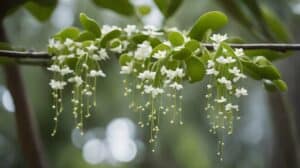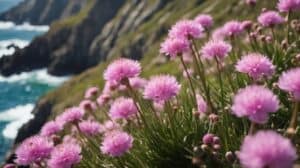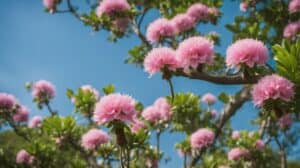The Licuala Grandis, commonly known as the majestic palm, is a beautiful tropical plant that is native to the rainforests of Southeast Asia.
It is a popular choice for homeowners and landscapers because of its lush foliage and impressive size.
However, caring for this plant can be challenging, and it requires specific conditions to thrive.

To ensure that your Licuala Grandis stays healthy and beautiful, it’s essential to understand its care requirements.
This article will provide you with essential care tips for the majestic palm, including information on its ideal growing conditions, watering needs, and common pests and diseases.
Whether you’re a seasoned plant enthusiast or a novice gardener, these tips will help you keep your Licuala Grandis looking its best.
Understanding the Licuala Grandis
Species Overview
The Licuala Grandis, commonly known as the Ruffled Fan Palm or the Majestic Palm, is a species of palm tree that belongs to the Arecaceae family.
It is native to the rainforests of Vanuatu, the Solomon Islands, and the Caroline Islands.
This palm tree is known for its large, fan-shaped leaves that grow up to 8 feet in diameter.
The Licuala Grandis is a slow-growing tree that can reach a height of 10-20 feet when mature.
The leaves of the Licuala Grandis are dark green in color and have a glossy, waxy texture.
The leaf blades are deeply divided, with each segment being ruffled and pleated, giving the tree its characteristic fan-like appearance.
The tree produces small, inconspicuous flowers that are followed by small, round fruit that turn black when ripe.
Native Habitat
The Licuala Grandis is native to the tropical rainforests of Vanuatu, the Solomon Islands, and the Caroline Islands.
It grows in the understory of the forest and thrives in warm, humid environments.
The tree prefers well-drained soil that is rich in organic matter, and it requires regular watering to maintain its lush appearance.
In its natural habitat, the Licuala Grandis is an important component of the rainforest ecosystem.
It provides shelter and food for a variety of animals, including birds, insects, and small mammals.
The tree also plays an important role in regulating the microclimate of the forest floor, helping to maintain a cool, moist environment that is essential for the survival of many plant and animal species.
Overall, the Licuala Grandis is a beautiful and unique palm tree that adds a touch of tropical elegance to any landscape.
With proper care and attention, this majestic palm can thrive in a variety of environments and bring joy and beauty to its surroundings.
Essential Care Tips

When it comes to caring for the Licuala Grandis, there are a few essential tips that every plant owner should keep in mind.
By following these guidelines, you can help ensure that your majestic Licuala palm stays healthy and vibrant for years to come.
Lighting Requirements
The Licuala Grandis prefers bright, indirect light.
Direct sunlight can scorch its delicate leaves, so it’s best to place the plant near a window with filtered light.
If you notice that the leaves are turning yellow or brown, it may be a sign that the plant is getting too much sunlight.
Watering Schedule
The Licuala Grandis likes to be kept moist, but not wet. Water the plant thoroughly, allowing excess water to drain out of the bottom of the pot.
Wait until the top inch of soil is dry before watering again. Overwatering can lead to root rot, so be sure not to let the plant sit in standing water.
Soil and Fertilization
The Licuala Grandis prefers well-draining soil that is rich in organic matter. A mixture of peat moss, perlite, and sand is ideal.
Fertilize the plant every two to three months with a balanced, water-soluble fertilizer.
Avoid fertilizing during the winter months when the plant is dormant.
Temperature and Humidity
The Licuala Grandis prefers warm, humid conditions. Keep the plant in a room with a temperature between 60 and 85 degrees Fahrenheit.
Mist the leaves regularly with a spray bottle to increase humidity.
If the air in your home is particularly dry, consider using a humidifier to keep the plant happy and healthy.
By following these essential care tips, you can help ensure that your Licuala Grandis thrives and adds a touch of tropical beauty to your home or office.
Common Challenges

Pest Prevention
Licuala Grandis is susceptible to infestations by pests such as spider mites, scale insects, and mealybugs.
To prevent these pests from attacking the plant, it is important to keep the plant healthy and well-maintained.
Regularly inspect the plant for any signs of pest infestation, such as webbing or small insects on the leaves.
If any pests are found, isolate the plant and treat it immediately with a suitable pesticide.
To prevent pest infestations, it is important to keep the plant in a clean and well-ventilated environment.
Avoid overwatering the plant, as this can create a favorable environment for pests.
Additionally, it is recommended to periodically wipe down the leaves with a damp cloth to remove any dust or debris that may attract pests.
Disease Management
Licuala Grandis is also susceptible to various diseases, including fungal infections and leaf spot.
To prevent these diseases, it is important to keep the plant in a well-draining soil and avoid overwatering.
If any signs of disease are noticed, such as discolored or wilting leaves, isolate the plant and treat it immediately with a suitable fungicide.
It is also important to regularly prune any dead or diseased leaves from the plant to prevent the spread of disease.
Additionally, avoid overcrowding the plant and ensure that it has adequate space and air circulation to prevent the development of fungal infections.
By following these simple pest prevention and disease management tips, you can help keep your Licuala Grandis healthy and thriving for years to come.
Frequently Asked Questions

What are the ideal lighting conditions for a healthy Licuala grandis?
Licuala grandis thrives in bright, indirect light. It is important to avoid exposing the palm to direct sunlight as it can cause leaf burn.
If you notice that the leaves are turning brown or yellow, it may be an indication that the lighting conditions are too bright.
How often should I water my Licuala grandis to maintain its health?
Licuala grandis prefers consistently moist soil, but it is important not to overwater.
Water the palm thoroughly when the top inch of soil feels dry to the touch.
During the winter months, reduce watering frequency as the plant’s growth slows.
What is the typical growth rate of a Licuala grandis palm?
Licuala grandis is a slow-growing palm, and it can take several years for it to reach its maximum height of around 10 feet.
The palm typically grows one to two new leaves per year.
Can you provide tips on fertilizing a Licuala grandis for optimal growth?
Licuala grandis benefits from regular fertilization during the growing season (spring and summer).
Use a balanced, slow-release fertilizer and apply it according to the manufacturer’s instructions. Avoid fertilizing during the winter months.
How can I tell if my Licuala grandis is not thriving, and what should I do?
If your Licuala grandis is not thriving, it may be an indication of poor lighting, overwatering, or nutrient deficiencies.
Look for yellowing or browning leaves, stunted growth, or wilting.
Adjust the lighting and watering as necessary and consider fertilizing if nutrient deficiencies are suspected.
What are some common uses for Licuala grandis in landscaping and interior design?
Licuala grandis is a popular choice for landscaping and interior design due to its attractive, fan-shaped leaves.
It is often used in tropical-themed gardens and as a statement plant in large containers.
In interior design, Licuala grandis is often used to add a touch of the tropics to living spaces and offices.














